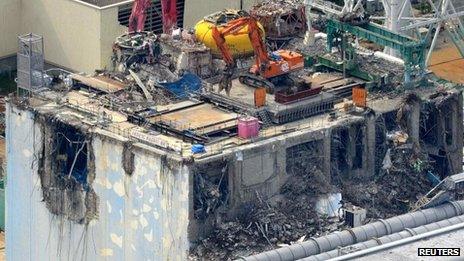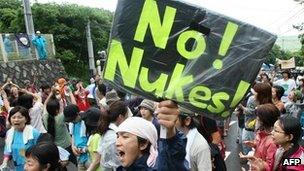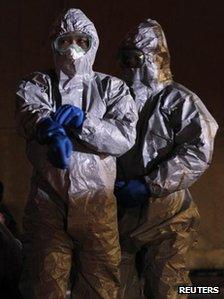How Tepco glossed over Fukushima's vulnerability
- Published

The authorities were "negligent" in preparing for a disaster, the report concludes
The devastating conclusion that Japan's Fukushima nuclear meltdown was an accident waiting to happen has grabbed the headlines.
But the investigation has also unearthed worrying questions about the catastrophe and its human cost that deserve attention.
Buried in the main body of the official report, external are new insights into how events unfolded and how as many as 60 local residents died as a result of the muddled response.
Most coverage has rightly focused on the finding that the meltdown was a "man-made disaster" caused by unhealthy collusion between the power company Tepco and the government regulators meant to oversee it.
That condemnation is all the more powerful when one thinks of the disaster's implications: a national spasm of fear, genuine concern that the reactors were dangerously out of control and a human legacy in which thousands of people are still living as refugees.
Last September I saw for myself the ghostly scenes in Tomioka, one of the towns inside the 20km (12 miles) exclusion zone, evacuated so rapidly that doors were left unlocked and prized animals were forgotten in the rush to escape.
Now the analysis by the investigating commission suggests that the original account of what went wrong may have glossed over crucial facts - and that the power station was far more vulnerable than previously admitted.
Damning conclusion
To understand the significance of this, one needs to recall the basic storyline put out by Tepco and the authorities in the wake of the crisis in March last year.
According to their account, the power plant survived the massive earthquake unscathed (which suggested that the company was adequately prepared) and only came unstuck when the tsunami turned out to be far larger than anticipated (implying that no-one could possibly have expected such an event).
What crippled the reactors, in this narrative, was the sheer size of the great wave that overwhelmed the sea defences and flooded the diesel generators meant to provide backup power.
The attraction of that official account was that it purported to show that the reactors and their buildings were robust and that it was only the freakishly vast scale of the tsunami that was to blame.

Many in Japan distrust the government's assurances that nuclear power is safe
But in the months after the accident, various figures questioned whether this picture was too convenient.
A few reports surfaced about possible damage inside the reactor buildings before the wave hit - in other words, the tremors had had an impact on the supposedly safe power plant - but official sources gave these allegations short shrift.
Now though, this comprehensive and very frank report for the Japanese parliament says Tepco was "too quick to cite the tsunami as the cause of the nuclear accident" and that "there is a possibility that the earthquake damaged equipment necessary for safety".
Specifically, the report confirms that:
the tremors were strong enough to cause damage and that seismic checks to the reactors, ordered before the disaster, had not been carried out
a minor loss of coolant in the system "from a crack in the piping" might have occurred but not been detected for as long as 10 hours
emergency backup power may have been lost before the tsunami hit the plant. Tepco and the government had reported the wave's arrival at Fukushima not when it actually reached the shore line but when it passed monitoring stations 1.5km offshore, and the difference in timing could be crucial to determine what caused the power to fail
several Tepco workers in Reactor building 1 - the oldest of the structures - witnessed a water leak which the commission believes was "not due to water sloshing from the spent fuel pool", implying it might have come from cracked pipework
In the investigation's view, all this adds up a damning conclusion: that blaming the wave - not the earthquake - was "an attempt to avoid responsibility".
Inadequate monitoring

The disaster was natural but the panic and confusion were described as "man-made"
Further revelations, tucked into an appendix at the back of the report, concern the response to the disaster and its human impact.
The investigators accuse the authorities of being "negligent" in preparing for a disaster and of failing to tell local residents what was happening.
A detailed survey found that only 20% of people closest to the plant knew about the accident when the first evacuation was ordered and most residents within 10km were only told the next day.
Of the people in Tomioka, the town I saw abandoned, less than 20% started moving on the day of the accident.
"Many residents," the report says, "had to flee with only the barest necessities and were forced to move multiple times or to areas with high radiation levels."
In one of the sharpest indictments, the investigators describe a picture of radiation monitoring so inadequate that people were sometimes moved from their homes into greater danger.
Although high radiation levels were found up to 30km from the plant, the authorities failed to tell people there and only moved them a full month later.
As many as 70% of people in five small towns had to move no fewer than four times.
The report relates how "hospitals and nursing homes in the 20km zone struggled to secure evacuation transportation and find accommodations".
And it highlights how this created a situation that went far beyond inconvenience and discomfort: "60 patients died in March from complications related to the evacuation".
'Fukushima 50'
Comments gathered from local people provide a moving glimpse of the confusion and fear that prevailed, including this one from a resident of Tomioka:
"We had no clue what was going on but we were told to evacuate to Kawauchi.
When we got there, we had to move from place to place and finally arrived at Miharu but we were told that it was full. We were told to go to the evacuation centre in Motomiya.
We later moved several times after that and are currently staying in a rental in Iwaki. Since then one year has passed but we have no idea of what we are going to do."
But if conditions were bad for local people, spare a thought for the workers inside the plant. There, too, the report discloses a pattern of poor training, a lack of preparedness and an absence of official concern.
Staggeringly, only 10% of subcontractors who were dealing with the disaster had received any kind of advance explanation about the possibility of an accident.
One employee described a nightmare scenario of knowing very little and then effectively being abandoned:
"No information whatsoever about the station blackout was delivered to the end-workers like us. I had to learn about the emergency evacuation orders for residents within 20km of the plant from TV.
"My employer knew there were several employees like me staying in the main anti-earthquake building. However, the company's managing director, deputy managing director and radiation protection supervisor all evacuated with their families.
"We found that the company car we were planning to use had been taken by Tepco employees, but a colleague gave us a ride."
Another employee told the commission: "I don't think there was much attention paid to the workers who actually dealt with the accident."
At the time there was worldwide admiration for the bravery of the "Fukushima 50" - the selfless workers who agreed to stay behind to work in the most dangerous parts of the complex.
But another - more realistic - side to that story becomes apparent in the testimony of a subcontractor.
He said: "On the news it was reported that the plant workers who were dealing with the accident were prepared to die, but I was watching the news, thinking that there is no way we were ready to die."
As Japan weighs whether to resume its reliance on nuclear power, all this evidence is highly relevant - whether the plants can withstand earthquakes, whether the authorities really are checking them, and whether local people are kept properly informed.
The fact remains that no-one has died of radiation poisoning from Fukushima. But the disaster has left a legacy of disrupted lives and distrust.